
The Definitive Guide On How to Cut Weight and Get Lean Without Fail
You know what’s great about dieting?
Nothing. Dieting sucks.
We’ve all been there…
One day you realize summer’s approaching and a wave of motivation overcomes you as you decide that you’re finally gonna cut weight and start eating healthy.
You start eating salads because hey, that’s what you’re supposed to do to get lean…right?
Two months pass and…
You haven’t lost A DAMN POUND.
Desperate to see a change in your belly fat, you try the Paleo diet or any other barbaric diet that your friend recommends to you (your friend who doesn’t even lift, by the way).
Now you’re sitting on your lunch break eating boring food, wondering how and why you even started a diet such as the Paleo, which requires you to eat high amounts of fat and little to no carbs.
You start questioning your sanity.
You then say screw it and, just like that, you’re back to where you started and unsatisfied with your body.
Sound familiar?
That’s because this happens time and time again!
The reality is that you’re not the only one
The reason many just can’t seem to get fit is because of the way fitness has been taught to us our whole lives.
“Eat healthy and exercise”, they say.
But what does that vague statement even mean?
That’s what I’m about to teach you here: how to get fit.
Specifically, how to lose weight…THE RIGHT WAY
My promise to you is that once you’re done reading this entire guide, you’ll have all the knowledge you need to start losing weight TOMORROW.
Let’s get started.
It’s all about calories in vs calories out
One of the biggest misconceptions about weight loss is that most people think that there are certain food types that cause you to lose weight, but this simply isn’t true.
You know, those “clean foods” like salads, oatmeal, brown rice, etc that everyone associates with fat loss?
Well, those “clean foods” aren’t really clean foods per se… In fact, there really isn’t such a thing as “clean foods”.
More on that later, but first…
If the types of food you eat aren’t what causes weight loss, then what does?
A caloric deficit.
Let that sink in for a bit.
Weight loss is NOT caused by doing cardio. It’s not caused by the types of food you eat either.
Weight loss is caused by being in a caloric deficit.
In other words, to consistently lose weight over a period of time, you need to burn more calories than you consume each day.
This is what you call “being in a caloric deficit”.

Now…
To see what a caloric deficit “looks” like, you need to know two important terms: BMR and TDEE.
We’ll dive into those next.
What does BMR and TDEE stand for and what do they mean?
Your BMR (Basal Metabolic Rate) is an estimate of how many calories you’d burn if you did nothing but lay in bed all day.
Of course, that scenario isn’t very realistic for most of us (at least I hope so, anyways).
In reality, we move around throughout the day as we go to the bathroom, go to work, walk to the kitchen, etc.
All of these activities burn calories.
So let’s call these calories (the ones burned from physical movements) X. And assume, for now, that you know exactly what your BMR is.
With some simple math, we can add X to your BMR to get a magical number: the TDEE.
TDEE (Total Daily Energy Expenditure) is an estimate of the TOTAL amount of calories you burn each day. Your TDEE takes into account both your BMR and your activity levels.
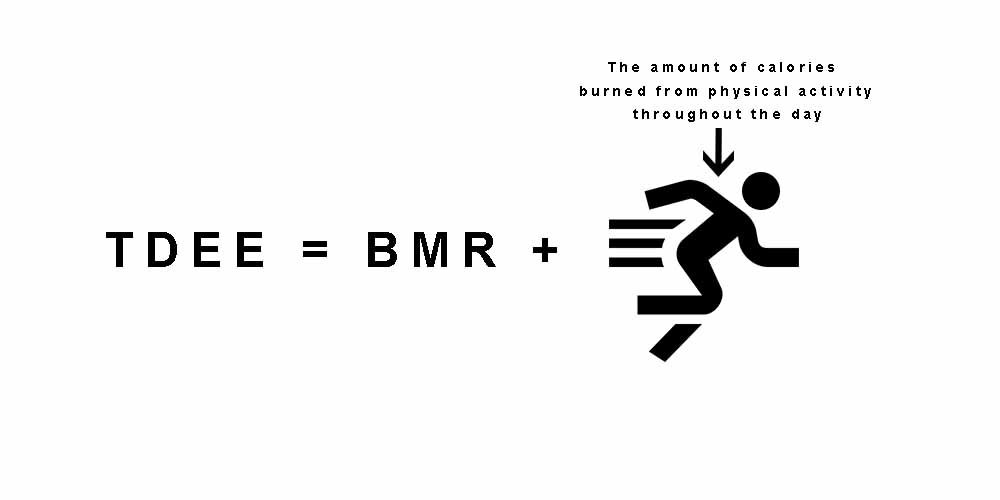 Why is TDEE a magical number?
Why is TDEE a magical number?
Because once you figure out your TDEE, you’re pretty much set! Your TDEE is where the magic happens.
Figuring out your TDEE is like setting down the foundational building blocks of your fitness journey.
Here’s how:
Say your TDEE (sometimes referred to as your “Maintenance” or your “Maintenance Calories”) happens to be 2500 calories.
What this means is that, your body burns 2500 calories per day.
It’s that simple. Don’t overthink it and make it difficult on yourself. If your TDEE is 2500, all that means is that you burn 2500 calories per day.
Now…hypothetically, what would happen if you were to eat EXACTLY 2500 calories each day, every day…forever?
Your weight would never go up or down. It would never fluctuate because you’d be eating at your maintenance.
That’s why it’s called your “maintenance”. Because by eating at your maintenance you’re essentially maintaining your body weight since you’re feeding it exactly what it burns.

And guess what…
If you eat above your maintenance, then you’ll be in a caloric surplus!
In a similar fashion…If you eat below your maintenance, then you’ll be in a caloric deficit. And most of the time that you’re in a caloric deficit, you’ll lose fat because your body will “feed” on your fat stores to make up for the absence of calories.

Notice how I said “most of the time you’ll lose fat” … Keep that in mind because I’ll be explaining it in a bit.
Before I get to that, however, you need to know how many calories are in one pound of fat so that you can create a deficit of an appropriate size. Otherwise, you’d just be taking a stab in the dark.
In one pound of fat there are 3500 calories.
So if you want to lose one pound of fat…then you must create a deficit of 3500 calories.
It would be unhealthy to attempt to create a deficit of 3500 calories in the span of just a few days.
The right way would be to create small deficits spread out through a week or two which, when added together, equal 3500 calories.
Okay, time to break this down with an example:
Say it’s January and you decided you wanna start cutting to get that summer bod by June. You have plenty of time to cut and, since you’re not in a hurry, you choose your rate of fat loss to be 1 pound per week.
That would mean you need to be in a 3500 calorie deficit spread out through 7 days. Meaning that each day, you’ll be in a 500 calorie deficit (3500 / 7 = 500).
If you wanted to cut weight at the rate of 2 lbs per week, then your caloric deficit would need to be 1000 calories below you TDEE, instead of 500 as we did with 1 lb per week.
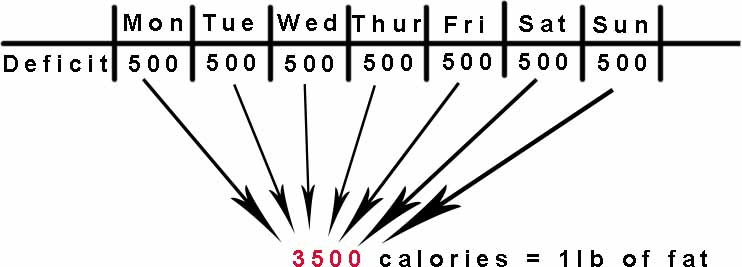
It’s important that you remember this: The bigger your deficit, the higher the chances are that you’ll LOSE MUSCLE instead of fat.
Why? Because muscle mass inherently has more nutrients that fat does. So if your maintenance calories are 2500 and you create a 1500 calorie deficit by eating only 1000 calories per day…then you’d be starving your body!
And when your body goes into starvation mode, it often taps into your muscle stores for energy since, as I stated before, muscle mass has more nutrients than your fat does.
Therefore, if you have an ridiculously big caloric deficit, then you might notice that you are losing weight…but there’s a high chance that weight is coming from your muscles.
And if your body starts burning more muscle than fat, than you risk becoming “skinny fat”. A skinny fat person is someone who is thin, but has high amounts of fat and little to no muscle.
You’d never be able to tell that a skinny-fat person carries much fat until they change into a bathing suit or take off their shirt. But when they do…it is NOT pretty.
Here’s one example:
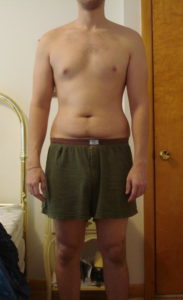
The key takeaway here: Less is not always more. Don’t make your deficit so high, thinking that you’ll lose more fat in a shorter amount of time. It doesn’t work like that.
With that being said, an optimal rate of fat loss is anywhere from 1 to 2 lbs per week. Anything faster and you risk becoming skinny fat.
How to calculate your TDEE (It’s simpler than you think)
You may be wondering:
“How do I find my maintenance calories (TDEE)?”
Lucky for you, finding out what your maintenance calories are is quite easy since there’s actually many calculators online that estimate your TDEE based on your personal stats.
We just so happen to have a TDEE calculator here ready for you to use on this site. You could also use a different TDEE Calculator if you’d like since they more or less give you the same number.
If you’d like to try ours, click here.
There is one caveat, however, and it’s critical that you engrave this into your mind:
No matter who’s TDEE calculator you use, the number it gives you will ALWAYS and ONLY be an estimate.

These calculators calculate your TDEE using a mathematical formula.
But you see…humans are too complex and there’s no way that one formula can describe the maintenance calories of 7 billion people.
Not a chance.
The only way to find your true TDEE is with time. Only until you’re 2-4 weeks into your cut will you be able to get a better picture of what your true TDEE is.
For example, if a TDEE calculator says Bob’s TDEE is 3000 calories and he wanted to lose one pound per week, then he would eat 2500 calories per day.
Now let’s say that Bob eats 2500 calories per day for 2 weeks straight and he discovers that his weight hasn’t budged. It hasn’t gone up nor has it gone down.
What can he deduct from this?
That since his weight didn’t fluctuate at 2500 calories per day, his TRUE maintenance is actually at 2500 calories.
And In the following week he would adjust his calories accordingly and eat 2000 calories per day to lose 1 lb per week.
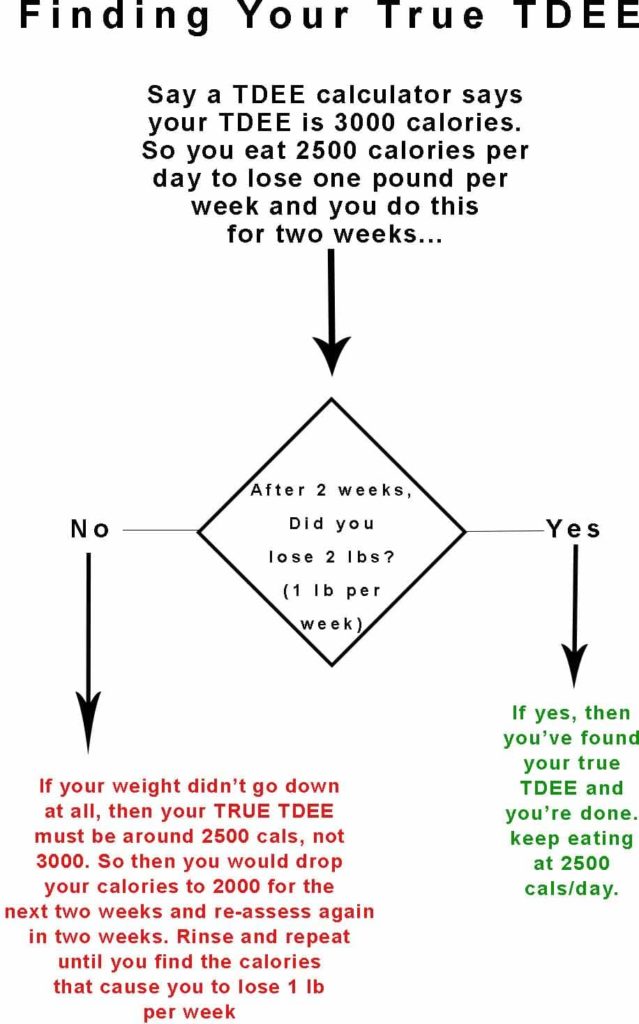
In this case, the calculator was way off, but that’s ok because it’s only a starting point. Never forget this.
You first start with a TDEE calculator and THEN you adjust accordingly as you go deeper into your cutting cycle.
So now you’ve got your maintenance calories and you know how to find your cutting calories given your desired rate of weight loss…
You’re almost done with creating your weight loss plan. There’s just one last step…
How to calculate your macros for weight loss
Now, if you’re already jumping ahead and asking “how do I calculate my macros?”, I want you to hold that question for sec.
Before we get into how to calculate your macros, it’s important that we find out WHY we should calculate our macros.
Not only will this give you better results, but by knowing the “why”, you won’t feel like you’re doing something pointless—which will, in turn, prevent you from losing motivation.
Let’s get started!
First:
What are macros? Macros is short for “macronutrients” and there are three of them: proteins, fats, and carbs.
When you calculate your macronutrients, you’re essentially figuring out how many grams of protein, fats, and carbs you’ll need to eat each day.
But why would it be important to calculate how much protein you need to eat per day on a cut?
“Err… to build muscle! Everyone knows that”
Well, not exactly.
By definition, when you’re on a cut, your body is constantly in a caloric deficit.
And if you’re in a caloric deficit, then you won’t have an adequate amount of calories to support any substantial muscle growth because to gain muscle, you have to be in a caloric surplus.
Therefore, when you cut, you will see little to no muscle gains.
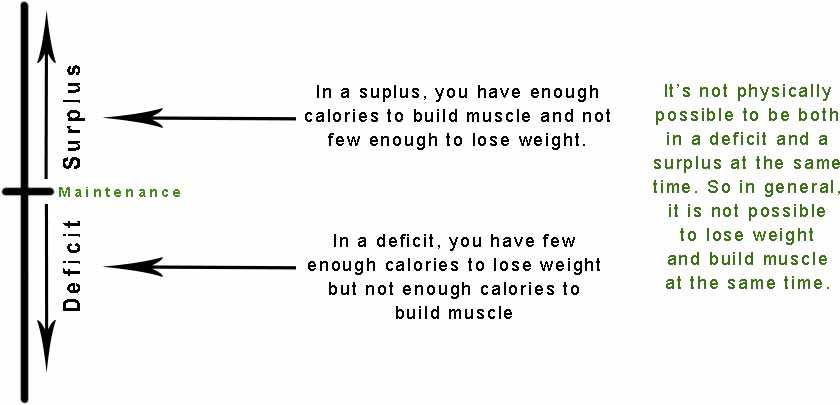
But don’t worry. When you’ve decided you want to start putting on mass, just simply switch to a bulking cycle (this will be explained in a separate post).
So then if one gains little to no muscle mass during a cut, then why have any protein at all?
Because protein has a hidden super power that most don’t know about: it’s AMAZING for preserving muscle.
That’s right.
If you take an adequate amount of protein during a cut, it will help you preserve your muscle mass so that your body burns your fat and not your muscle. That way, you won’t become skinny fat!
On to the next one: Fats.
Fats are a bit simpler. Fats regulate your body’s hormones and make sure everything is working properly.
So it’s important to calculate how many grams of fat you should eat per day because not eating enough fats will cause a hormonal imbalance and negatively affect your progress.
Another reason to calculate your fats is because eating too much fat is not only unhealthy, but by eating more fat than necessary, you’re taking up precious calories that could be used on some delicious carbs!
Which brings us to the third macronutrient (and the least important of the three): carbs.
Carbs are the least important macro of the three. And while carbs are an efficient fuel source for our bodies, being deficient in carbohydrates does not results in illness. So it’s very possible to survive on a very small amount of carbohydrates.
In fact, carbs were rarely in our cavemen ancestor’s diet. Their diet mostly consisted of meats and fats.
Therefore, because having carbs in our diet isn’t crucial, they are taken into account last when calculating macros.
So how do you actually calculate your macros?
Well, it just so happens that our TDEE Calculator also calculates your macros so you don’t have! It’s free and available for everyone to use. You could also use someone else’s calculator if you’d like.
The other option is to calculate your macros by hand. I’ll leave that for a separate blog post since that’s more of an advanced topic.
For now, you’ll do fine using our macro calculator or anyone else’s.
How to track your calories and macros with ease
Lucky for you, tracking your calories and macros is the easiest part.
To start tracking your calories and macros, simply download any calorie tracker app of your choice. I prefer the My Fitness Pal app.
Step 1. Once you’ve made an account, set up your calorie goal (ignore the percentages for carbs, protein, and fat).

Step 2. Begin tracking your calories and macros.
There are multiple ways to track a food item:
a) Scanning the item’s bar code

b) Searching the item by name

c) Weighing your food and entering the serving amount you’re going to eat (You should definitely buy a food scale)

As you enter food items in your MyFitnessPal app, it keeps track of all the calories (and macros) you’ve eaten throughout the day. Once you reach your daily calorie goal then that means you’re done for the day.
And that is it…literally.
Everything you need to know to get started on your journey to get fit, shredded, ripped, whatever…is now in your hands! Everything.
All you have to do now is get started.
Also, notice how up till this point, I haven’t mentioned anything about what foods you should eat. Stick around till the end to see my concluding thoughts on this.
Do I need to do cardio?
Nope.
To lose weight, you don’t need to do any cardio as a matter of fact.
Listen…
I’m not trying to knock cardio. I actually advise that you do cardio due to its many health benefits.
Cardio helps maintain a healthy heart, improves stamina and endurance, and makes you feel good all around.
But I don’t want you to get the wrong idea and think that you need to do cardio to lose weight or even worse…that cardio IS what burns fat and makes you lose weight.
This is wrong.
As I stated above, the only thing that will make you lose weight is a caloric deficit.

So then how is it that countless amount of people have lost weight by doing cardio weekly?
Because cardio burns calories NOT fat.
And because cardio burns calories, doing cardio can sometimes result in a caloric deficit.
For example:
If your TDEE is 2500 calories and you’ve eaten 2500 calories then you’ve eaten at maintenance and your bodyweight will stay the same.
But if you decide to go for a run and you burn 500 calories on your run, then your “total” calories for the day will be about 2000 calories.
Since 2000 calories is below your TDEE of 2500, you will lose weight.
However, in this case, you will be losing weight and burn fat because of the calorie deficit that the cardio created, not because cardio itself burned fat.
To illustrate this point even more…
You could get the same results as in the above example by not doing any cardio at all AND by stopping yourself once you hit 2000 calories because then your “total” calories for the day would be 2000 which is the exact amount as in the previous example where you did cardio.
In other words…in terms of aesthetics, not eating 500 calories gives the same result as burning 500 calories from doing cardio.
Now, don’t go off celebrating because you just discovered you don’t need cardio to get fit.
Definitely still do cardio if you’d like, but make sure you’re doing it for health reasons.
Whether you choose to add cardio into your dieting regimen or not, TDEE calculators will take this into account when calculating your TDEE and your macros.
Essentially, when a TDEE calculator spits out your maintenance calories, your desired cardio level is already “built into” those maintenance calories.
Now it’s your turn. Go.
Everything that’s been explained thus far—this methodology for losing weight—actually has a name: IIFYM.
IIFYM stands for “if it fits your macros” and is often called “Flexible Dieting” as they can be used interchangeably.
It’s called “if it fits your macros” because, essentially…you can eat WHATEVER you want AND lose weight as long as…it fits your macros!
Do not confused IIFYM with a diet because it isn’t one.
That’s why I mentioned earlier that I haven’t told you anything about which foods to eat.
That’s because at the end of the day it’s calories in vs calories out and all that matters (in terms of body composition) is HOW MUCH you eat, NOT WHAT you eat.
If that isn’t the most liberating thing you’ve heard in regards to weight loss than I don’t know what is.
Yes, you can have the cheese burger or that slice of cake if you have enough calories for it and if it won’t cause you to go over your daily macros.
That’s the beauty of flexible dieting.
The world is now in your hands, all you have to do now is go get it.
Cheers,
-John
P.S. We just launched the first first Podcast episode. Check it out here: The BS to Avoid in the Fitness Industry
References
- Smith, C. F., Williamson, D. A., Bray, G. A., & Ryan, D. H. (1999). Flexible vs. Rigid dieting strategies: relationship with adverse behavioral outcomes.Appetite, 32(3), 295-305.
- Halton, T. L., & Hu, F. B. (2004). The effects of high protein diets on thermogenesis, satiety and weight loss: a critical review. Journal of the American College of Nutrition, 23(5), 373-385.
- Mela, D. J. (2001). Determinants of food choice: relationships with obesity and weight control. Obesity research, 9(S11), 249S-255S.
- Lemon, P. W. (2000). Beyond the zone: protein needs of active individuals. Journal of the American College of Nutrition, 19(sup5), 513S-521S.
- Tipton, K. D., & Wolfe, R. R. (2004). Protein and amino acids for athletes.Journal of sports sciences, 22(1), 65-79.
- Timko, C. A., & Perone, J. (2005). Rigid and flexible control of eating behavior in a college population. Eating Behaviors, 6(2), 119-125.
- Phillips, S. M., & Van Loon, L. J. (2011). Dietary protein for athletes: from requirements to optimum adaptation. Journal of sports sciences, 29(sup1), S29-S38.
- Simopoulos, A. P. (2008). The importance of the omega-6/omega-3 fatty acid ratio in cardiovascular disease and other chronic diseases. Experimental Biology and Medicine, 233(6), 674-688.
- Norton LE, Wilson GJ, Layman DK, Moulton CJ, Garlick PJ. (2012) Leucine content of dietary proteins is a determinant of postprandial skeletal muscle protein synthesis in adult rats. Nutr Metab (Lond). 2012 Jul 20;9(1):67. doi: 10.1186/1743-7075-9-67. PubMed PMID: 22818257; PubMed Central PMCID: PMC3488566
- Kidd, P. M. (2007). Omega-3 DHA and EPA for cognition, behavior, and mood: clinical findings and structural-functional synergies with cell membrane phospholipids. Alternative Medicine Review, 12(3), 207.
- Baer, D. J., Stote, K. S., Paul, D. R., Harris, G. K., Rumpler, W. V., & Clevidence, B. A. (2011). Whey protein but not soy protein supplementation alters body weight and composition in free-living overweight and obese adults.The Journal of nutrition, 141(8), 1489-1494.


